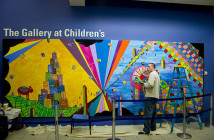The Mildred S. Lee Gallery of the Rose Art Museum sounds like the courtyard garden of a large apartment complex. It is currently the site of 12 white gallery pedestals of varying heights, each one topped with a capsule of some sort with sound emanating from it. This installation is another edition of Alvin Lucier’s Chambers, in which small speakers or sound emitting devices are encased in empty objects. In this incarnation of the work, the objects range from a thimble to a chicken-shaped culinary mold to bamboo dim sum baskets, and in each object a speaker plays different pre-recorded sounds from various environments.
The piece is fascinating in that I found myself compelled to visit each object just to hear what sounds Lucier decided to emit from each canister. Rush hour in a train station, a restaurant in Germany, birds chirping were among Lucier’s set-list, though it would be difficult to tell you this just by listening. The work attempts to reveal the resonant qualities of each of its 12 ‘chambers’ along with the space where the object is installed. In the process of viewing and listening to each work the viewers’ relationship with each piece is enriched by its emanating sounds. The viewer is enabled to achieve a greater sense of the shape and material of the object just by listening to it.
Much of Lucier’s recent work has dealt with the “spatiality of sound.” Most recently, he collaborated with Sol Lewitt on a piece titled Curved Wall (Wesleyan) at Wesleyan University in Middletown, CT. Lewitt’s experimentation with the space complimented Lucier’s and just like in Chambers, the viewer/listener’s cognizance of the space was enhanced by Lucier’s meticulously placed speakers. In the mid 1990’s, Lucier worked in reverse by placing microphones inside objects within his installations.
Many of his ‘compositions,’ though written for orchestras and solo performers alike, are mere instructions for creating sound. A performer needs only to know how to use the prescribed instrument to create sound not music, per se, in order to ‘play’ one of his pieces. In a New Music Box interview last spring, Lucier admitted “when I’m writing a piece, I have to de-compose, I have to not compose… I have to eliminate those things that distract from the acoustical unfolding of the idea.” He claims to write music by time and frequency, notating it exactly, and when he was asked what a performer should know about his work before undertaking it, he replied only, “It's what they need not to know.”
Originally, Chambers was a performance piece first carried out in 1968. Lucier instructed the performers only to carry battery operated radios and noise making toys inside vessels ranging from paper bags to their own cupped hands through spaces of varying sizes and shapes. The Chambers performance enabled the viewer/listener to hear the different resonances of each space in that as the individual pieces were moved from room to room the listener could gauge the acoustical properties of each room by comparing it to the last. The stationary element of the Rose Museum’s Chambers installation disallows this quality, considerable limiting any acoustical or resonation discovery by the listener. To add, the sound quality of many of speakers was so low, sounding similar to 70’s era television speakers, that it was difficult to tell whether the object or the speaker itself was causing any decipherable augmentation to the sound.
Lucier admits that he has chosen a difficult media to work with as sound waves are subtler than other media and they don’t necessarily behave the way you want them to. Even more difficult is the audience’s ability to appreciate his work; the untrained ear often left with an unintelligible drone not unlike my experience as I rounded the corner into the Lee Gallery. In essence, Lucier has merely placed speakers into inanimate objects to make the speakers sound different. He wishes for us to take into account the space surrounding the installation, but as the installation is static, it is very difficult to appreciate its environmental qualities. Sound relies on its environment to take its form, but recognizing or even noticing that form, without a comparison space, such as was the case in the original Chambers (1968), is not possible for the untrained ear perhaps except for in the most extreme cases, e.g. echo chambers.
The work has the same issues that some New Media art suffers from in that it is insularly Sound Art. Lucier shows us what sound can do in the same way that many New Media artists only show us what new technology can do, instead of actually using the new technology as a media for creating new work that doesn’t rely solely on its technology for its raison d’être. This technique for making art came off well when Abstract Impressionists started to just make ‘paint paintings’ no long before Chambers was created in its original, mobile form. However, Abstract Impressionism’s visually discernible beauty and accessibility ensures it a place in pop-culture. Chambers will likely only live on as a charming, though intellectually dissatisfying museum piece.
Links:
The Rose Art Museum at Brandeis University
Alvin Lucier
"Alvin Lucier: Chambers" is on view September 15 - December 11, 2005 at The Mildred S. Lee Gallery of the Rose Art Museum of Brandeis University.
All images are courtesy of the artist's website.




